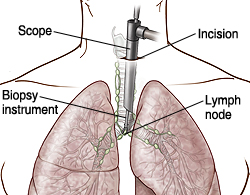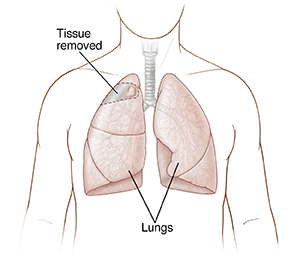Surgery for Lung Cancer
Surgery can be used to both diagnose and treat lung cancer. Surgery is often used to treat the type of lung cancer called non-small cell lung cancer. In most cases, surgery is used if the cancer is found in an early stage, which means it's small and hasn't spread beyond the lung. You will need to prepare for lung surgery. Work with your healthcare provider to learn more about what to expect before, during, and after surgery.
Mediastinoscopy
A mediastinoscopy is used to look at the space between the lungs and under the breastbone (sternum). It might be done to take out a tiny piece of tissue, called a sample. This process is called a biopsy. The sample is then used to figure out the extent (stage) of the cancer. The procedure is done in an operating room with general anesthesia. This means medicine will be used to put you into a deep sleep and prevent pain during the procedure.
During this procedure, the healthcare provider puts a scope through a small cut (incision) made at the top of the sternum. The scope is a long, thin, lighted tube. It's slid into the mediastinal space. This is the space between your lungs and behind your breastbone. Your healthcare provider can see lymph nodes and other tissues in this area through the scope. Lymph nodes may be removed through the scope so they can be tested for cancer. Sometimes the swollen nodes are on one side of this mediastinal space. If so, the incision for the scope may be made on the side of your sternum, between two ribs.
If no cancer is found in the lymph nodes, you may need more surgery (see below). If cancer has spread to the lymph nodes, more surgery isn't usually done. This is because the chance of curing the cancer with surgery is low. This decision is based partly on which lymph nodes the cancer has spread to. It's also based on how much of the healthy lung must be taken out to remove all of the cancer.
 |
| Lymph nodes may be removed. |
Surgery
The type of surgery done to treat lung cancer depends on the size of the cancer and where it is within the lung. The goal of surgery is to remove all of the cancer and the nearby lymph nodes. This often means part or all of the lung is taken out. The lungs are made of sections or lobes. The right lung has three lobes, and the left lung has two.
These are the types of lung surgeries used to treat cancer:
-
Segmentectomy or wedge resection. These surgeries remove only part of the lobe with the tumor and a small edge (margin) of healthy tissue around it. The difference between the two surgeries is more lung tissue and lymph nodes are removed with a segmentectomy.
-
Lobectomy. Surgery is done to remove an entire lobe of the lung. This is the preferred type of surgery for lung cancer, even if the tumor is small.
-
Pneumonectomy. This surgery removes the whole lung. It might be needed if the tumor is close to the center of the chest.
 |
| Surgery may remove all or part of a lung. |
If the cancer is found in an early stage, when it's small and hasn't spread, surgery may cure it. Your healthcare provider will consider the tumor’s size and where it is when deciding how much of the lung to remove. Your overall lung health will also be taken into account.
In some cases, a thoracoscopy procedure called video-assisted thoracic surgery (VATS) may be a choice. It's typically used only for early-stage lung cancer near the outside of the lung. With VATS, the lung tissue is removed through several small cuts (incisions) using special tools and a thin, lighted tube. The tube has a video camera at the end to let the healthcare provider see inside the chest. Less pain, a shorter hospital stay, and quicker healing are benefits of this type of surgery. Robotically-assisted thoracic surgery might be another choice. It's like VATS, but the surgeon sits at a computer control panel and moves robotic arms to do the surgery. With either of these, it's important to have surgery done by someone who has a lot of experience with these special methods.
You will get general anesthesia before surgery. This means medicine will be used to put you into a deep sleep and prevent pain. You'll also be connected to a machine that breathes for you during surgery.
Risks and possible complications
Lung surgery has certain risks and possible complications. These include:
-
Risks of general anesthesia
-
Infection
-
Bleeding
-
Air leaking through the lung wall
-
Pneumonia
-
Heart problems
-
Blood clots in the legs or lungs
-
Shortness of breath (especially in people with other lung problems)
Talk with your healthcare providers about what problems to look for and when to call them. Make sure you know what number to call with questions or problems, including after office hours, on weekends, and on holidays.